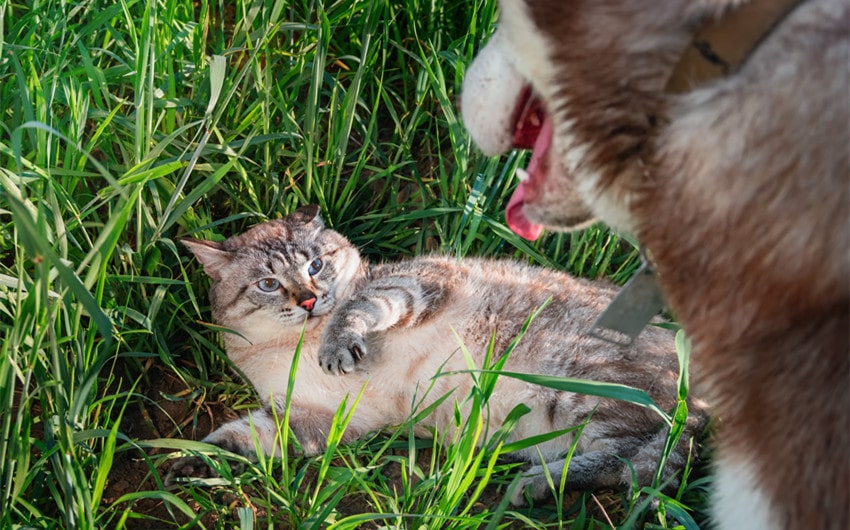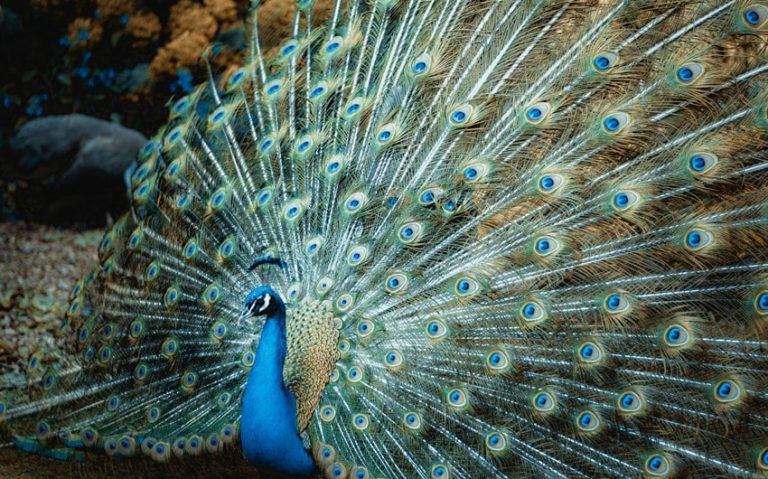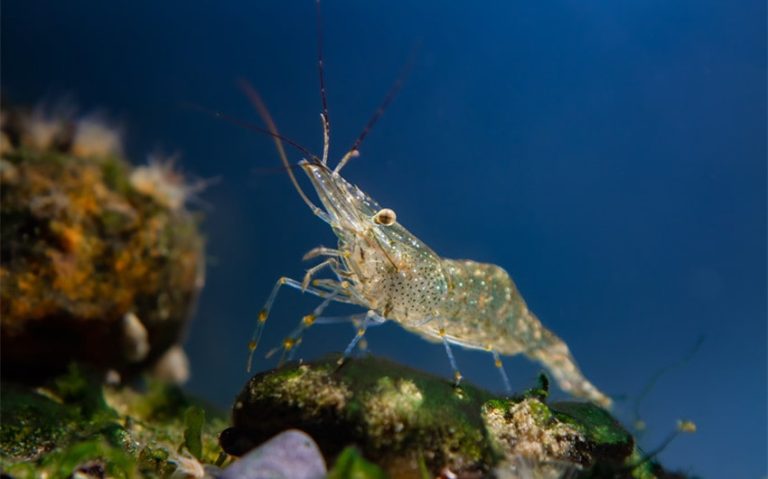Why Do Cats and Dogs Hate Each Other: Discover 5 Reasons
It’s a classic image: a cat arching its back as a dog barks excitedly nearby. This dynamic often leads people to wonder, why do cats and dogs hate each other? While the phrase “hate” might be strong, there are actually instinctual and behavioral reasons why these animals can clash.
Differences in body language, territorial instincts, and natural reactions can lead to misunderstandings, making it seem like they’re natural enemies. Understanding the root of these behaviors can help pet owners create a peaceful environment where both pets feel secure and understood.
Reason 1: Natural Instincts and Predatory Behavior
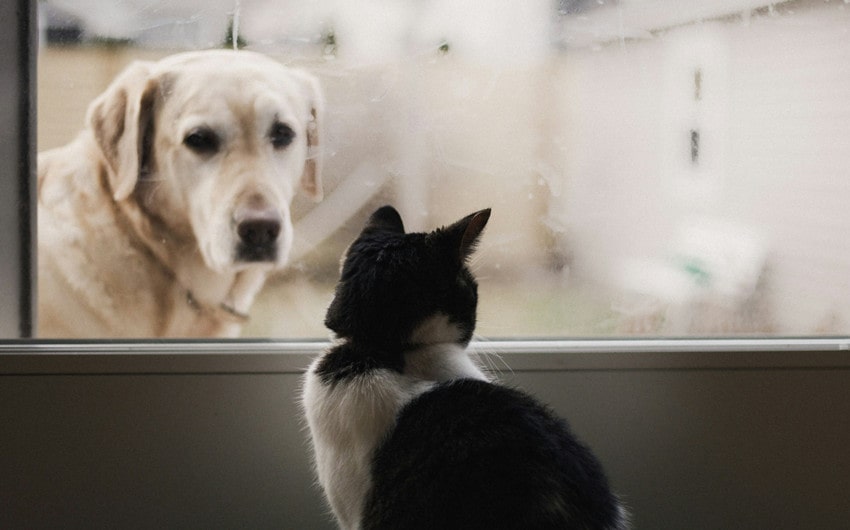
The natural instincts of cats and dogs can play a major role in why these two animals often struggle to get along. Their evolutionary backgrounds and behaviors as predator animals with different social structures can create tension and misunderstanding.
Cats as Both Predators and Prey
Cats have evolved with a unique set of instincts that make them both hunters and potential prey. This dual role influences how they interact with other animals, including dogs. While cats are skilled hunters of smaller animals, they are also cautious of larger predators, which can include dogs. This tendency to be vigilant and defensive around bigger animals means that cats often approach dogs with a wary, guarded attitude, ready to escape or defend themselves if they sense a threat.
A cat’s cautious nature can be misunderstood by dogs, who may interpret a cat’s alertness or defensive posture as an invitation to engage, which can trigger a cat’s flight-or-fight response. This wariness is especially strong if the cat hasn’t been exposed to dogs before, as they’ll be more likely to see the dog as a potential threat rather than a friend.
Dogs as Social Pack Hunters
Dogs, on the other hand, evolved as pack animals with a social, cooperative nature that is very different from a cat’s more solitary instincts. As pack hunters, dogs tend to approach other animals, including humans and cats, with excitement, curiosity, and sometimes boldness. This eagerness to explore and establish social contact can be overwhelming to cats, who generally prefer a slower, more controlled approach.
Additionally, dogs often approach others head-on, sniffing or jumping to express interest. While this behavior is friendly in dog terms, it can feel threatening to a cat who perceives such direct and energetic attention as aggressive. Cats are more likely to respond with caution or defensiveness, which dogs may misinterpret as hostility or playfulness, leading to further misunderstandings.
Certain dog breeds also have strong prey drives—instincts to chase or pursue smaller animals—which can trigger a cat’s flight response. If a dog interprets a cat’s sudden movement as something to chase, this instinctual reaction can quickly lead to a chase-and-hide scenario, reinforcing the idea that cats and dogs “hate” each other.
Reason 2: Body Language Misinterpretations

Cats and dogs communicate in distinctly different ways, which can lead to frequent misunderstandings. While humans can often interpret these signals correctly, cats and dogs don’t naturally understand each other’s body language. This misinterpretation of cues can result in tension, fear, or even defensive behavior.
Tail Movements
Tail language is one of the most common forms of expression in both cats and dogs, yet it often leads to mixed signals between the two. For dogs, a wagging tail typically means friendliness, excitement, or an invitation to play. They wag their tails to show enthusiasm or to signal that they’re happy to engage with another animal or person. However, for cats, a tail flicking or wagging often indicates agitation, alertness, or a warning to back off. A high, rigid tail may signal confidence or dominance, while a low, twitching tail often signals anxiety or potential aggression.
When a dog wags its tail enthusiastically around a cat, the cat may interpret this as a sign of alertness or aggression rather than friendliness. Similarly, a cat’s flicking tail can appear playful to a dog, leading the dog to approach, which the cat may perceive as threatening. This simple misunderstanding can cause immediate tension and lead to conflict.
Eye Contact and Posture Differences
Eye contact and posture are other key areas where cats and dogs differ in communication. Dogs often maintain direct eye contact and have a forward posture when they’re interested, curious, or even excited to play. This behavior is natural and unthreatening to other dogs but can feel confrontational and intimidating to cats, who typically interpret prolonged eye contact as a challenge or threat.
Cats prefer more subtle, indirect forms of communication. For example, slow blinking is a way that cats signal trust and relaxation, while direct eye contact is reserved for defensive or territorial situations. When a dog stares at a cat with excitement or curiosity, the cat may feel threatened or challenged, leading it to respond with defensive behaviors like hissing, arching its back, or retreating. In turn, a dog may interpret these behaviors as a form of play or a provocation, causing further confusion.
Vocalizations
Dogs and cats vocalize differently, and these sounds often lead to miscommunication. A dog’s bark, growl, or whine can seem loud and intimidating to a cat, even if the dog’s intent is simply to get attention or initiate play. Barking, in particular, can be unsettling to a cat, who may view it as a sign of aggression, causing them to hide or become defensive. In response, a cat may hiss or growl, sounds that dogs might interpret as aggressive.
For cats, hissing, growling, or even yowling are signs of warning or discomfort, intended to signal that they feel threatened. Dogs, however, may interpret these sounds as part of a game or as a reason to approach further. This misinterpretation of vocal cues can escalate quickly, with each animal perceiving the other as aggressive or unapproachable, reinforcing the tension between them.
Reason 3: Territorial and Personal Space Differences

Cats and dogs have very different perspectives when it comes to territory and personal space. These instincts influence how each animal interacts with others in their environment, especially in shared spaces. Differences in territoriality and boundaries can create tension and misunderstandings, as cats and dogs may struggle to respect each other’s space.
Cats’ Strong Territorial Instincts
Cats are naturally territorial animals who feel secure when they have established, controlled spaces that they consider their own. This territorial instinct is especially pronounced with cats, as they prefer familiar areas with predictable routines. Cats often mark their territory by rubbing their scent on objects or scratching surfaces, claiming certain areas as their own. For a cat, having a designated “safe zone” is crucial for feeling secure and in control.
When a dog enters the scene, especially a new or curious dog, it may invade these established territories without recognizing the boundaries. Dogs often wander freely around spaces they consider part of their “pack territory,” which can make a cat feel threatened, defensive, or even aggressive. For instance, if a dog approaches a cat’s favorite resting spot or food area, the cat might interpret this as a violation of its territory, prompting hissing, swatting, or retreating behavior as a warning to the dog.
Dogs’ Social Boundaries and Curiosity
Unlike cats, dogs are naturally social animals with a more flexible approach to personal space. As pack animals, dogs are accustomed to sharing space with others, including humans and other animals. This social nature leads dogs to approach others with enthusiasm, curiosity, and minimal regard for personal space boundaries. When dogs encounter new animals or people, they often show affection through close contact, sniffing, or playful behaviors, which may not be well-received by cats.
To a dog, approaching a cat for a sniff or a gentle nudge may be a friendly gesture, but to a cat, this invasion of personal space can feel overwhelming or intimidating. Dogs also tend to follow others around, particularly if they’re curious, which can cause a cat to feel “chased” or cornered. This disregard for a cat’s boundaries can trigger defensive behavior, as the cat may see the dog’s actions as threatening rather than friendly.
Conflicting Need for Space and Boundaries
Cats and dogs also differ in their need for solitary time versus social interaction. Cats are generally more independent and appreciate solitude, often retreating to quiet, secluded spaces when they want to relax. Dogs, on the other hand, thrive on interaction and may interpret a cat’s withdrawal as an invitation to engage or play. This can lead to misunderstandings, as a cat’s attempt to create distance is often met with a dog’s pursuit, escalating the cat’s discomfort or sense of being cornered.
Additionally, when a dog follows a cat into spaces the cat considers “off-limits,” like a cozy hiding spot or a perch, the cat may feel that its sanctuary is being invaded. This dynamic can create constant tension, as the dog’s instinctive curiosity conflicts with the cat’s need for privacy. Over time, repeated disruptions of personal space can make a cat more defensive, responding with swats, hissing, or even attempts to avoid the dog entirely.
Protective Behavior Over Resources
Cats and dogs also tend to guard their resources—such as food, water, and resting spots—within their claimed territory. For example, a cat may feel anxious if the dog approaches its food bowl or preferred resting area. This resource guarding can escalate into territorial aggression, especially if either animal feels threatened by the other’s proximity to these valued items.
Dogs, too, may be protective of their resources and may view a cat’s curiosity as a challenge to their territory. If a dog perceives the cat as trying to “take over” its food, toys, or resting area, it may respond by barking, growling, or posturing to assert dominance. These conflicts over resources can intensify the tension between them, reinforcing the perception that cats and dogs “don’t get along.”
Reason 4: Lack of Early Socialization
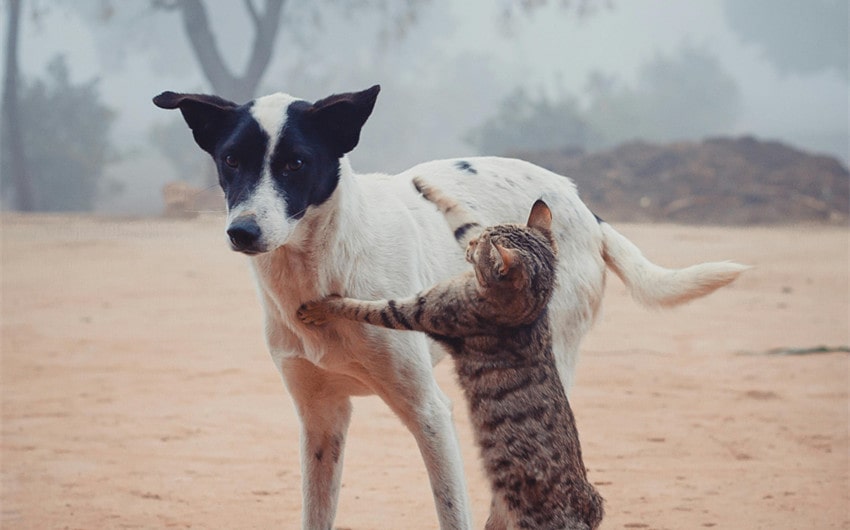
One of the main reasons cats and dogs may struggle to get along is the lack of early socialization. If a cat or dog hasn’t been exposed to the other species during its formative months, it can lead to wariness, fear, or even hostility. Early socialization helps pets learn each other’s communication styles, but without it, misunderstandings and distrust often arise.
Growing Up Without Exposure to Each Other
Socialization during a pet’s early life—generally within the first few months—is crucial for shaping how they perceive and react to other animals. Cats and dogs that are raised without exposure to each other are likely to view one another as unfamiliar and potentially threatening. For instance, a dog that’s never encountered a cat may instinctively treat it as a small prey animal rather than a companion. Similarly, a cat that hasn’t grown up around dogs may see them as larger, unpredictable animals to be wary of.
This lack of familiarity can lead to initial fear or aggression, as neither animal knows how to interpret the other’s behavior. Without positive early interactions, a dog’s curiosity can feel intrusive to a cat, and a cat’s caution may seem unfriendly to a dog. These first impressions can be difficult to change once they’re formed, creating lasting tension between the two.
Different Social Behaviors and Boundaries
Early socialization helps animals develop a tolerance for different types of behavior, but without this exposure, cats and dogs can struggle to understand each other’s social cues. For example, puppies and kittens that are raised together learn to interpret each other’s play styles, body language, and boundaries. A dog that’s socialized with cats as a puppy will likely grow up understanding when a cat wants to be left alone and when it’s open to interaction.
In contrast, a dog unfamiliar with cats may treat them as playmates in the same way they would other dogs, which can lead to frustration or fear on the cat’s part. Cats raised without dogs may be unaccustomed to a dog’s social boundaries, like sniffing or jumping, which can feel invasive. This lack of familiarity with each other’s social “rules” can cause tension and lead to defensive behaviors.
The Role of Positive Associations in Socialization
For cats and dogs to develop a comfortable relationship, it’s important that they associate each other with positive experiences. In early socialization, pets learn that the presence of the other animal can bring rewards, like treats, affection, or playtime. These positive associations help reduce fear and build a foundation of trust. Without early socialization, however, cats and dogs may not have developed these positive associations, leading them to feel apprehensive or even defensive in each other’s presence.
For example, a dog that has been socialized with a cat may be more inclined to approach calmly and gently, associating the cat’s presence with treats or a calm environment. Conversely, a dog without these positive associations might approach with excitement or unpredictability, startling the cat and leading to a negative response. Positive early experiences help both animals develop a sense of mutual respect, making future interactions smoother.
Difficulty Adapting to New Behaviors Later in Life
Without early socialization, it can be challenging for adult cats and dogs to adapt to each other’s behaviors. Older animals are often set in their ways, making it harder for them to accept the habits of a new species they don’t understand. For instance, an adult dog may see a cat as an intruder if it hasn’t been introduced to cats before, while an adult cat may become stressed or defensive around an unfamiliar dog.
Additionally, socializing adult cats and dogs often requires more patience and controlled introductions, as they haven’t had the chance to build familiarity from a young age. Adults tend to have ingrained habits, and the presence of an unfamiliar animal can be seen as a disruption to their routine. Introducing a cat and dog later in life requires careful, gradual steps to help them adjust, which can take longer than if they had been exposed to each other during their formative months.
Reason 5: Environmental Factors and Triggers
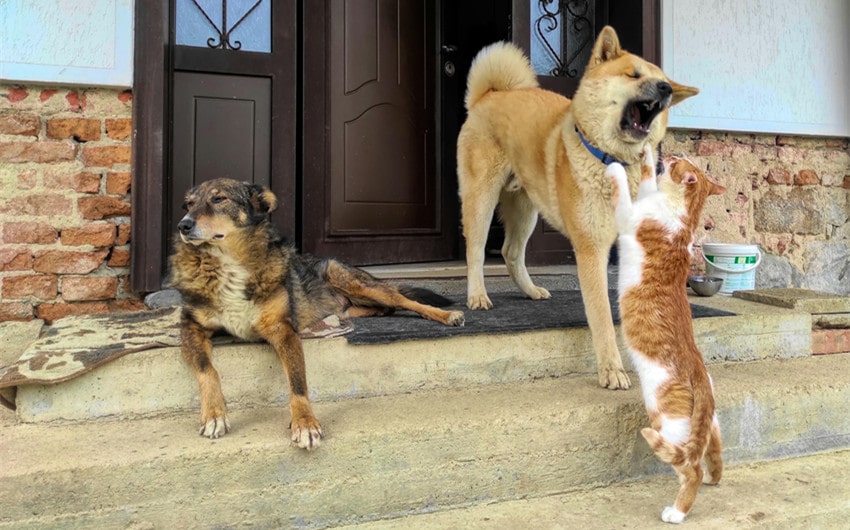
Environmental factors can play a significant role in how cats and dogs perceive each other and interact, particularly when they are sharing a home or adapting to new surroundings. Various triggers, including shared spaces, competition over resources, and stress-inducing situations, can exacerbate existing tensions or create new ones, often leading to conflict.
Stress from New or Shared Environments
Moving to a new environment or sharing space with a different species can be overwhelming for both cats and dogs. Cats, in particular, are highly sensitive to changes in their surroundings and can become anxious when their environment is altered. This sensitivity can make a cat wary of any new animals, including dogs, who may seem like intruders in a space the cat considers its territory. When cats feel their space is compromised, they may become more defensive and less tolerant of the dog’s presence.
Dogs may also feel stressed when adapting to a new home or having to share it with a cat, especially if they are territorial by nature. A dog may instinctively assert its presence in the space, which the cat may perceive as a threat. Additionally, when cats and dogs are introduced to each other in an unfamiliar environment, both may feel vulnerable, leading them to act on defensive instincts rather than curiosity. This tension can be amplified in high-stress settings, causing both animals to be on edge and less willing to tolerate each other.
Competition for Resources
Competition over resources like food, water, toys, and even human attention can heighten conflicts between cats and dogs. Both species have natural instincts to protect their resources, and any perceived threat to these essentials can lead to territorial behavior or defensive actions. For example, if a dog approaches a cat’s food bowl, the cat may feel the need to guard it and may respond by hissing or swatting. Similarly, a dog may growl or become possessive if a cat approaches its toys or sleeping area.
This resource guarding can extend to less obvious things, like human attention or preferred resting spots. Both cats and dogs form attachments to their owners, and when they perceive that the other animal is receiving more attention or encroaching on “their” space, jealousy or possessive behavior can arise. This competition can create an ongoing cycle of conflict, as each animal seeks to reclaim what it feels entitled to, leading to tension and even aggressive behavior.
Disruption of Routine and Personal Space
Both cats and dogs rely on routine to feel secure, and any disruption can create stress that manifests as irritability or defensiveness. Cats, in particular, are creatures of habit and tend to follow specific routines for eating, sleeping, and playing. The introduction of a dog who is more active, curious, or unpredictable can disrupt these routines, causing the cat to feel unsettled or frustrated. For example, if a dog interrupts the cat’s quiet time or takes over a favorite resting spot, the cat may respond by distancing itself or displaying defensive behaviors.
Dogs, while generally more adaptable, can also be affected by changes to their routine caused by a new pet in the home. If a dog feels that its exercise, playtime, or interactions with its owner are being compromised due to a cat’s presence, it may become anxious or reactive. These disruptions can make both animals more sensitive to each other’s presence, leading to a heightened sense of territoriality or the need to assert dominance in shared spaces.
Overstimulation and High-Energy Environments
Certain environments can overstimulate cats and dogs, especially if there is a lot of noise, activity, or sudden changes that heighten their stress. High-energy situations, such as guests visiting, children playing, or even other pets, can make both animals more reactive and on edge. For a cat, this overstimulation can lead to hiding, hissing, or swatting if it feels cornered or threatened. A dog, on the other hand, may respond to the energy by barking, chasing, or attempting to engage in rough play, which the cat is likely to perceive as aggressive.
Overstimulation is especially problematic when introducing a cat and dog for the first time, as each animal is already trying to assess the other’s intentions. In chaotic environments, neither animal can relax, and this added stress can create negative first impressions that are difficult to overcome. By contrast, calm and controlled settings help both animals feel secure, making them more likely to observe each other peacefully.
Lack of Designated Safe Spaces
Both cats and dogs benefit from having designated areas where they can retreat and feel secure, but cats in particular need elevated or enclosed spaces where they can escape if they feel threatened. If a home doesn’t provide these safe spaces, it can heighten the stress between a cat and dog, as the cat may feel it has nowhere to go to avoid the dog. A lack of safe zones may cause the cat to be more defensive and anxious, leading to frequent confrontations with the dog.
Similarly, dogs may need spaces where they can relax without feeling they are intruding on the cat’s territory. When each animal has a defined area to retreat to, it reduces the likelihood of accidental encounters or territory conflicts. Creating these safe spaces can help prevent unnecessary tension and give both animals a sense of security in their shared environment.

